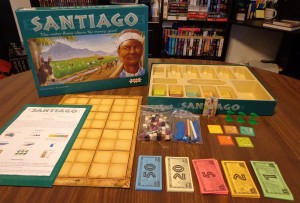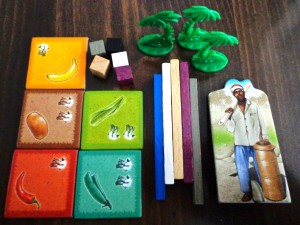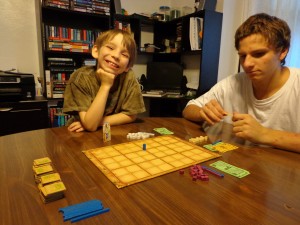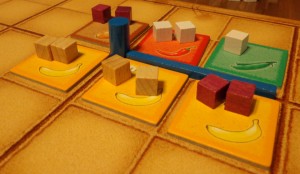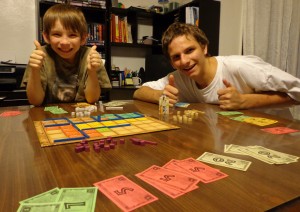Ever try owning a potted plant but are the type of person who tends to forget things? Important things, like how plants need water and all of that jazz? How did that work out for you? Withered and died huh? Well, I guess you just haven’t played enough Santiago to know better…yeah, let’s go with that.
Santiago is a game all about control. The precious commodity that players are trying to control? Water…specifically, canal irrigation systems. In Santiago, players will be placing crops (plantation tiles) on the board and bribing the current canal overseer to encourage them to place the next irrigation canal where they want it to go. Let’s quickly check out the components and gameplay before we head into the review.
Components
Escudos (Money) – Players will be using Escudos to bribe the canal overseer to encourage them to place irrigation canals in locations best suited for them, as well as use it to bid on the available plantation tiles every round.
Irrigation Canals – These blue canals provide water to all of the spaces that it touches.
Proposal Canals – Before irrigation canals are placed, each player will be using these to propose to the canal overseer on where they’d like them to place the next canal.
Spring – The spring is placed on the board in the beginning of the game, signaling where the water will begin flowing from. Irrigation canals branch off from this location.
Canal Overseer Figure – This figure is given to whoever becomes the canal overseer, giving them special powers during that round.
Plantations – Players will be placing these on the board during every round and come in various forms (bananas, sugar cane, potatoes, beans, and red pepper).
Yield Markers – These square cubes are placed on plantations to mark which player owns what plantation, as well as determine how long a plantation can be left unirrigated before turning into a desert tile.
Palm Trees – Palm trees are only used during the variant rule set that is found in the manual. They add an extra yield marker to the plantation that is currently occupying it.
Game Board – The board is made up spaces that are large enough to fit plantation tiles. Along the perimeter of each of the 2×2 quadrants is an outline where canals can be placed, this is to ensure that every space on the board can be irrigated.
Setup & Gameplay
At one random intersection where the ditches meet up (thick brown lines), the players will place the spring token. So many canals and face down stacks of plantation tiles are arranged nearby, depending on how many people are playing the game. Each player picks a color and gets the appropriate proposal canal piece and yield markers, as well as ten starting Escudos. Each player also receives one blue canal piece. The first player figure is given to someone at random.
The game is played over a series of so many rounds, depending on how many people are playing the game. Each round is made up of seven phases which can be summed up as follows:
1. Turning over plantation tiles and bidding on them – Players turn over the top tile on each plantation stack and then bid once on them, starting with the player to the canal overseer’s left.
2. Changing the canal overseer – Whoever bid the lowest or passed first becomes the new overseer immediately.
3. Taking and placing plantation tiles – Whoever bid the highest gets first pick of one of the plantation tiles. The next highest bid gets the next pick, and so on and so forth. When a player picks their tile, they immediately place it on the board and put the appropriate number of yield markers on it (as shown on the tiles themselves). Players who pass place one less yield marker on the tile they picked and placed.
4. Trying to bribe the canal overseer – Players, in turn and starting with the person on the overseer’s left, place a proposal canal on the board accompanied by a monetary bribe. The canal overseer can only choose one of the proposals or go with what they want (at a cost of the highest bribe plus one), if none of the proposals match up with their idea.
5. Extra irrigation – Each player begins the game with one bonus blue canal piece…at this time, players can place them if they so wish. Only one canal can be built this way per round and each player only has one to use, so they must choose to use them wisely!
6. Drying – This phase is skipped in the last round of the game. Any non-irrigated plantations lose a yield marker. If a plantation doesn’t have any, it turns into a desert tile.
7. Collecting income – This phase is skipped in the last round of the game. Each player gets three Escudos.
After the last round, all non-irrigated tiles switch to desert automatically and players receive money for all of the remaining tiles in which they have yield markers. The amount of money that is received in this fashion is equal to the number of connected like plantation tiles times the number of yield markers of a particular color present. Whoever has the most money at the end of the game wins!
The above is simply an overview of the game, but should still give you an idea of what the game is like. If you want to see more of the rules in detail, then you can check out the manual here:
The Review
The components were of good quality and the manual did a good job in teaching me how to play. I also appreciate that the makers included palm trees for an optional variant. You can already get a lot of mileage out of the standard game and the addition of the variant is simply icing on the cake.
There’s a good mix of strategy and a lot of money management. Players will constantly be deciding whether the bid or bribe that they are about to play is too high or too low and end up coming back to bite them later. Spend too much on bribes initially and you risk funding other players with the money they need to win a really nice plantation tile during a bid down the line. Spend too little, and you risk leaving your plantations out to dry and might miss out on some really lucrative plantation tiles.
It’s pretty difficult to compare Santiago to anything in my collection. It’s got a farming theme but incorporates a bid & bribe mechanic that adds a twist that I wasn’t expecting. It turned out to be a very social experience, one that I’m not sure will be a good fit for every family. We all enjoyed the idea behind the game, however I was worried that the kids would get a bit competitive to the point where I would have to step in and remind them that they were just playing a game. Luckily, I was able to keep the mood light enough to where that didn’t happen.
I’ll say this…if you’re playing Santiago with highly competitive people or with people who offend easily, there’s a good chance that feathers will be ruffled. As such, I recommend the game to mature adults and children who have their temper in check and don’t mind some friendly competition. Parents who play this game with their kids should take extra care to keep the game fun and the mood light. With the right group of people, Santiago can be a fun, social experience. With the wrong group of people, it can bring game night to a grinding halt.
Final Verdict: 5/10

